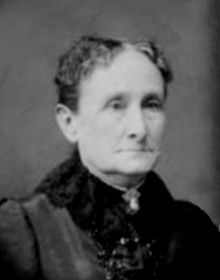Occupation School Teacher, Poet Name Rebecca Lard | Role Poet | |
 | ||
Born Rebecca HammondMarch 7, 1772New Bedford, Massachusetts ( 1772-03-07 ) Resting place Coffee Creek Baptist Church Cemetery Notable works Miscellaneous Poems onMoral and Religious Subjects,On the Banks of the Ohio Spouse Samuel Lard(m. 1801-1828; divorced) Children Julia (Lard) HammondSamuel Adams LardHoratio Nelson LardCharles Lard Died September 28, 1855, Paris Crossing, Indiana, United States | ||
Rebecca Hammond Lard (born Rebecca Hammond; March 7, 1772 – September 28, 1855), is called by some critics "the first poet in Indiana". Her poetry reflects on the lives of the early people in Indiana and the colonists in Vermont. Lard's works are mainly religious and meditative in tone, but draw their inspiration in part from the Bucolics and Georgics of Virgil. She is best known for Indiana's first book of poetry, On the Banks of the Ohio, a poem she is believed to have written.
Contents
Early life
Rebecca (sometimes Rebekah) Lard was born on March 7, 1772, in New Bedford, Massachusetts, to parents Jabez and Priscilla (Delano) Hammond. The following month, she was baptized at Mattapoisett in Rochester, Massachusetts. Lard was the oldest of ten children. Jabez Hammond Jr. named his other children, from the next of oldest to the youngest: Abigail, Caleb, Jabez Delano, Priscilla, George C, Mary, Rhoda, Thankful and Philip. At age ten, Lard moved with her father's family from Rochester to Woodstock, Vermont. On her mother's side of the family, her great grandmother was sister to William Penn.
At the age of fourteen Lard began to teach at a school, she became a teacher despite a lack of schooling herself but relied on her own talents. Her brother, Jabez Delano Hammond, followed in her footsteps and began teaching at the age of fifteen, eight years later. Hammond continued to read and practice medicine in Reading, Vermont, and also to read and practice law in Cherry Valley, New York, where he was elected a member of Congress. Lard would later dedicate her first book to this brother.
Family
Rebecca Lard married Samuel on February 12, 1801 in Woodstock, Vermont and had four children. She continued to teach, being her chief occupation there. About 1807 Samuel moved the Lard family to Hancock, Vermont, and from there to Cherry Valley, New York, where her brother was living at that time. From there, Samuel decided to migrate to Indiana.
Lard refused to join him, taking her children back to Vermont to be with her own family, instead. Marcus Davis Gilman said of her, "Her life struggle appears to have been a severe one, having a family of four children dependent upon her for support from their childhood, but bravely did she triumph over all obstacles".
Samuel Lard filed land entry papers in 1815 for 160 acres in Montgomery Township, Jennings County, Indiana. Their son, Samuel Jr., joined his father in 1817. They made a permanent home there on Graham Creek. In 1819, Samuel Jr. returned to convince his mother to bring the family west.
Poetry
Lard's first collection of 143 pages of poetry, Miscellaneous Poems by a Lady, was first published by David Watson of Woodstock in 1820 as Miscellaneous Poems on Moral and Religious Subjects by a Lady. She dedicated this work to her brother, Jabez Delano Hammond. In these poems, Lard talks about beauty, death, and feeling by comparing them to phenomena in nature.
Lard's twelve-page poem, On the Banks of the Ohio, was published in 1823 as a booklet and was featured widely by many magazines and papers. This is recorded as Indiana's first published poetry. In this poem, Lard talks about the area's landscape and the beauty of undisturbed nature. She also describes the native people as dangerous.
An old edition of Lard's five-page volume of verse is maintained in the collection of the Historical and Philosophical Society of Ohio, Cincinnati, and an undated clipping of the Cincinnati Gazette identifies the work as that of Mrs. Lard, "a lady of Indiana".
Divorce and death
Lard left Montgomery township in 1823 to become a school teacher in Vernon, Indiana. A cabin was built there by John Vawter to serve as the area's schoolhouse and board Mrs. Lard as a means of payment. She was one of the first women school teachers in Jennings county and taught some of the best minds in Indiana. Among her students were Squire Billy Deputy's children.
In 1826, Samuel started divorce proceedings against Lard for not returning after leaving him. He was granted a divorce on March 4, 1828, in the Jennings County court. Lard later left the Vernon area of Jennings county and returned south. She started teaching at Solomon's Temple by Coffee Creek.
Rebecca Lard died on September 28, 1855, and is buried at the Coffee Creek Baptist Church Cemetery in Paris Crossing, Indiana. The epitaph on her tombstone reads: "she has done what she could".
